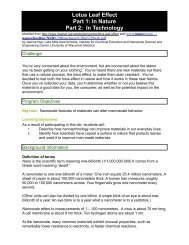Environment and Nanotechnology - Institute for Chemical Education
Environment and Nanotechnology - Institute for Chemical Education
Environment and Nanotechnology - Institute for Chemical Education
Create successful ePaper yourself
Turn your PDF publications into a flip-book with our unique Google optimized e-Paper software.
<strong>Nanotechnology</strong> is Making Solar<br />
Power Cheaper<br />
One example is the use of organic photovoltaic<br />
cells (OPV) instead of the more common silicon<br />
crystal solar cells.<br />
• Made from light-sensitive polymers [1]<br />
• These polymers can be dissolved in liquids,<br />
<strong>and</strong> so they can be used in screen printing,<br />
inkjet printing, <strong>and</strong> spray deposition (like spray<br />
paint) which make manufacturing materials<br />
using high-throughput processes like roll-to-roll<br />
printing (think newspaper printing) possible,<br />
<strong>and</strong> this can drive the cost down [2].<br />
• Though conversion efficiency is typically on<br />
the order of 5% [1], scientists are working on<br />
improving that through controlling nanoscale<br />
morphology [2].<br />
Resources: [1] Jacoby, M. "The Power of Plastic." <strong>Chemical</strong> & Engineering News 88.34 (2010): 12-16.<br />
[2] Mayer, A. C., et al. "Polymer-Based Solar Cells." Materials Today 10.11 (2007): 28-33.













